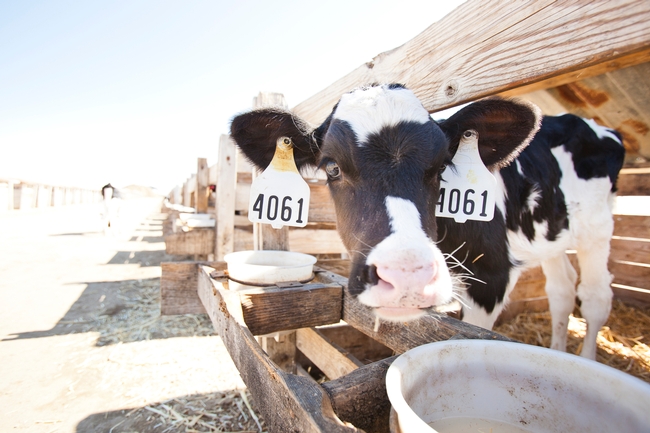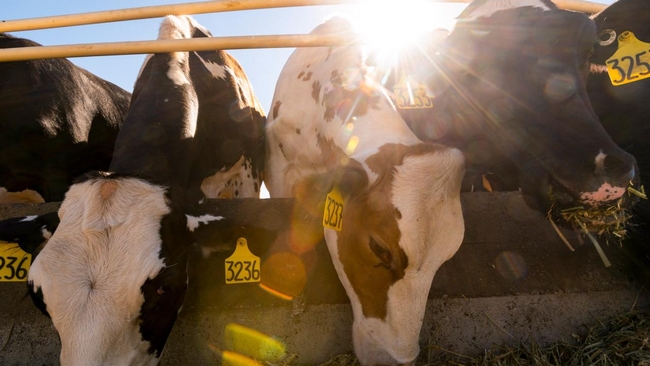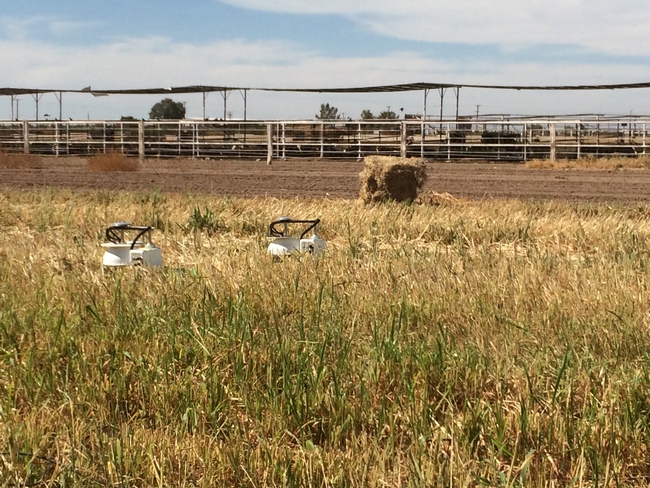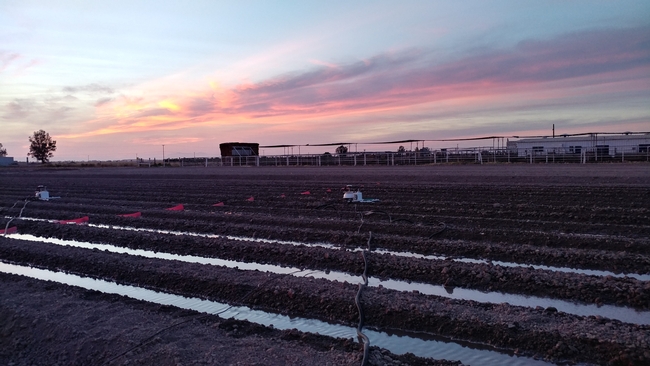
Posts Tagged: emissions
Report: California on path to significant dairy methane reduction
Researchers say dairy farms on track to achieve full 40% reduction goal by 2030
The California Dairy Research Foundation and University of California, Davis CLEAR Center announced on Dec. 14 the release of a new analysis of methane reduction progress titled "Meeting the Call: How California is Pioneering a Pathway to Significant Dairy Sector Methane Reduction." The paper, authored by researchers at UC Davis affiliated with UC Agriculture and Natural Resources, concludes that efforts are on track to achieve the state's world-leading target for reducing dairy methane emissions by 40% by 2030.
The report, written by distinguished professors of livestock emissions and agricultural economics, takes a comprehensive look at progress and projections, expanding upon the analysis of progress previously conducted by the California Air Resources Board. By documenting achievements to date, additional reduction efforts already funded, historic and current economic trends, and the projected availability of new solutions, the analysis lays out a workable path toward meeting California's goal. The pathway shows that California dairy farms are on track to achieve the full 40% dairy methane reduction goal and will reach “climate neutrality” by 2030. Climate neutrality is the point in which no additional warming is added to the atmosphere.
“This analysis shows that California's dairy sector is well on its way to achieving the target that was established by SB 1383 in 2016,” said CDRF's Executive Director Denise Mullinax. “With much important work still ahead, a clear understanding of this pathway helps dairy farmers, policy makers, researchers, and other partners make decisions to strategically press forward.”
The report outlines the need for continued implementation of California's four-part strategy for dairy methane reduction: farm efficiency and herd attrition, methane avoidance (alternative manure management), methane capture and utilization (digesters), and enteric methane reduction. Continued alignment of state and federal climate-smart agricultural approaches and incentives will also be critical to maintaining progress.
"Milk demand is growing, and California is among the world's low-cost suppliers of dairy products. It follows that effective California policy to reduce dairy greenhouse gas emissions must recognize that measures that cause milk production to exit the state do not mitigate global climate change," said study co-author Daniel Sumner, Distinguished Professor in the Department of Agriculture and Resource Economics at UC Davis. "Therefore, measures to help off-set mitigation costs, provide positive incentives for adoption of low-cost emission-reducing practices, and help stimulate innovation in methane reduction, are the economically efficient approaches."
The paper recognizes that enteric methane from the dairy and other livestock sectors is a significant source of greenhouse gas emissions in the U.S. and California. Several feed additives are expected to become commercially available in the next several years, which could be used to reduce enteric methane emissions from California's dairy herd.
“Adoption of enteric feed additives will become a valuable tool for dairy value chains to meet their greenhouse gas reduction goals,” said co-author and professor Ermias Kebreab, associate dean of global engagement and director of the World Food Center at UC Davis. “While this report provides only a broad overview of some of the most promising solutions, there is an incredible amount of research being conducted at UC Davis, nationally and internationally. The dairy industry, global food companies, state and federal agencies, and others continue to invest heavily in supporting enteric mitigation research efforts.”
The report finds that methane reductions from California's programs and projects in place today, coupled with the implementation of a moderate feed additive strategy to reduce enteric emissions, is on track to reduce between 7.61 to 10.59 million metric tons of methane (CO2e) by 2030, all from the dairy sector alone.
The collective investment in California's dairy methane reduction effort — from public and private funding — now exceeds $2 billion and counting. The California dairy sector, in coordination with the California Department of Food and Agriculture, was recently awarded up to $85 million by the United States Department of Agriculture under the Partnerships for Climate-Smart Commodities. The funding will leverage additional matching state funds and private capital investments, for a total of more than $300 million in new investment.
“It is important to highlight California's investments and success to date as an example of what is possible within the global livestock sector,” said co-author Frank Mitloehner, UC Davis animal science professor and air quality specialist in Cooperative Extension, and director of the UC Davis CLEAR Center. “California dairy farmers have demonstrated tremendous progress toward the state's methane reduction goal over the past several years. Given the short-lived nature of methane, this rapid reduction is an important contribution to the global effort to quickly limit climate warming.”
The author's analysis was prepared by Gladstein Neandross & Associates (GNA). Funding was provided by CDRF as part of its work to support an innovative and sustainable California dairy industry.
Drip irrigation in arid regions can cut greenhouse gas emissions, improve air quality
Study at Desert Research and Extension Center highlights agriculture's sustainability role
Under the blistering sun of Southern California's Imperial Valley, it's not surprising that subsurface drip irrigation is more effective and efficient than furrow (or flood) irrigation, a practice in which up to 50% of water is lost to evaporation.
But a recent study also concludes that drip irrigation can dramatically reduce greenhouse gas emissions from soil – which contribute to climate change and unhealthy air quality in the region – without sacrificing yields of forage crops alfalfa and sudangrass.
“It was really exciting to see,” said lead author Holly Andrews, a National Science Foundation postdoctoral fellow at the University of Arizona. “The crop yield was at least maintained and in some cases increased, but the water use and gaseous emissions were especially decreased under drip irrigation.”
Desert REC crucial to collecting data
Andrews and her colleagues gathered data from field studies at University of California Agriculture and Natural Resources' Desert Research and Extension Center, a crucial hub of desert agriculture research for more than 100 years. Studies in that context are increasingly important, as much of California and the Southwest becomes hotter and drier.
“We already have this history of looking at drip irrigation at this site, so our study was trying to build on that,” said Andrews, who lauded Desert REC's facilities and staff.
In their study published in Agriculture, Ecosystems & Environment, researchers found that – in comparison to furrow irrigation – drip irrigation in alfalfa slashed per-yield soil carbon dioxide emissions by 59%, nitrous oxide by 38% and nitric oxide by 20%.
Nitrous oxide is a greenhouse gas with nearly 300 times more warming potential as carbon dioxide, and nitric oxide is a precursor to ozone and major contributor to air pollution.
While drip irrigation only decreased water demand 1% in alfalfa, the practice led to a substantial 49% decrease in irrigation for sudangrass. For more fertilizer-intensive sudangrass, drip irrigation also reduced soil emissions of nitrous oxide by 59% and nitric oxide by 49% – the result of drip irrigation making those fertilizers more efficient.
Water management can help mitigate climate change
Studying alfalfa and sudangrass – forage crops with very different fertilizer requirements – was a strategic choice by the researchers. They are number one and number three on the list of most widely grown crops by acreage in the Imperial Valley (Bermudagrass, another forage crop, is number two).
With so much land dedicated to producing these crops, the adoption of drip irrigation at scale could deliver significant benefits to residents' health and quality of life.
“The thought that saving water can increase yields while lowering the emission of trace gases that affect regional air quality and Earth's climate is quite encouraging,” said Pete Homyak, an assistant professor of environmental sciences at UC Riverside who contributed to the study. “This is especially true for the Imperial Valley, an arid region where water is a limited resource and where residents are exposed to bad air quality.”
Homyak, who is affiliated with UC ANR through UC Riverside's Agricultural Experiment Station, said that this study illustrates how changes in water management can substantially mitigate agricultural impacts on the environment.
The study findings should encourage growers to replace furrow irrigation systems with drip irrigation infrastructure – especially in combination with financial incentives from the state, such as cap-and-trade and carbon credit programs, that can help defray high installation costs.
“It really is worthwhile if you're thinking sustainability and environmental activism in how agriculture can actually support climate change mitigation,” Andrews explained. “These practices might be a way that we can start to change that picture a little bit – and make agriculture more sustainable by tailoring irrigation management to local climate conditions.”
In addition to Andrews and Homyak, the other study authors are Patty Oikawa, California State University, East Bay; Jun Wang, University of Iowa; and Darrel Jenerette, UC Riverside.
Biodigester turns campus waste into campus energy

Last week, on Earth Day, the university and Sacramento-based technology partner CleanWorld unveiled the UC Davis Renewable Energy Anaerobic Digester (READ) at the campus' former landfill. Here, the anaerobic digestion technology Zhang invented is being used inside large, white, oxygen-deprived tanks. Bacterial microbes in the tanks feast on campus and community food and yard waste, converting it into clean energy that feeds the campus electrical grid.
“This technology can change the way we manage our solid waste,” Zhang said. “It will allow us to be more economically and environmentally sustainable."
It is the third commercial biodigester CleanWorld has opened using Zhang's technology within the past two years and is the nation's largest anaerobic biodigester on a college campus.
The system is designed to convert 50 tons of organic waste to 12,000 kWh of renewable electricity each day using state-of-the-art generators, diverting 20,000 tons of waste from local landfills each year. It is expected to reduce greenhouse gas emissions by 13,500 tons per year.
The READ BioDigester encompasses several of the university's goals: reducing campus waste in a way that makes both economic and environmental sense, generating renewable energy, and transferring technology developed at UC Davis to the commercial marketplace.
The biodigester will enable the more than 100 million tons of organic waste each year that is currently being landfilled in the U.S. to be converted to clean energy and soil products. The READ BioDigester is a closed loop system, moving from farm to fork to fuel and back to farm. Whatever is not turned into biogas to generate renewable electricity can be used as fertilizer and soil amendments — 4 million gallons of it per year, which could provide natural fertilizers for an estimated 145 acres of farmlands each day.
Nearly half of the organic waste, or feedstock, needed to operate the biodigester to full benefit will come from UC Davis dining halls, animal facilities and grounds. CleanWorld is working with area food processing and distribution centers to supply the remaining amount. Meanwhile, UC Davis will earn 100 percent of the project's green energy and carbon credits and receive all of the electricity generated.
Anaerobic digestion is an age-old process. However, Zhang's patented technology made it more efficient — capable of eating a broader variety and bigger quantity of waste, turning it into clean energy faster and more consistently than other commercial anaerobic biodigesters.
View a video about the UC David biodigester here:
(This blog post is condensed from a UC Davis news release about the biodigester.)
Additional information:
- Read the full press release
- Download biodigester photos
- Vine video: From lunch to lights
- Visit http://www.cleanworld.com/
UC to measure energy and greenhouse gas footprints of orchard crops

A new study underway at the UC Sustainable Agriculture and Research and Education Program (SAREP) aims to help growers and policymakers better understand the energy use, greenhouse gas emissions, and carbon sequestration potential of orchard systems throughout California.
As trees grow, they draw carbon dioxide from the air to create sugar and cellulose for food and growth, locking some of that carbon into their wood as the trees age — in some trees for 25 years, in others like walnuts, for upwards of 150 years. Proper use of that carbon at the end of an orchard's life can have major implications for the overall greenhouse gas footprint of an orchard operation. Trees used for power generation after orchard removal have the potential to offset fossil-fuel related emissions created throughout the orchard's life.
"Our preliminary study in almonds shows that the amount of fossil fuel emissions saved in this way is equal to almost three-quarters of the greenhouse gas emissions generated during the whole 25-year lifespan of the orchard, using current practices," says the project's director, Sonja Brodt, SAREP academic coordinator. "We think that this information could help to position orchard crops favorably for a consumer base that is increasingly climate-smart."
This study, funded by the California Department of Food and Agriculture's Specialty Crops Block Grant Program, will focus on prunes, peaches, walnuts and almonds in all of the primary production regions of the state.
Many farm management practices have an energy use component that the project will consider including water and fertilizer use, tractor use and post-harvest transportation. By understanding which parts of orchard operations use the most energy as well as how much energy is required to manufacture and distribute inputs before they even arrive at the farm, growers can increase the efficiency of their practices. Industry groups can also develop more scientifically-sound grower sustainability programs to improve energy efficiency more broadly for the state's many tree crop growers.
"Energy is one input into agriculture that we have not thought about much from a whole supply chain point of view," says Gabriele Ludwig of the Almond Board of California, which funded a preliminary study on energy use and emissions in almond production and handling. "Yet the costs of energy, especially from fossil fuel sources, keep going up. The life cycle assessment approach used in this project can provide an analysis of where increased efficiencies may be possible."
The project's collaborators include the UC Cooperative Extension's Sutter-Yuba office, the UC Davis Department of Civil and Environmental Engineering, Department of Land, Air, and Water Resources, the Department of Plant Sciences, and graduate students in Horticulture and Agronomy and International Agricultural Development.
By working with growers throughout the state, project staff will be able to ensure that orchard management practices included in the project's models are representative of current practices. Growers interested in providing confidential input about their orchard practices are invited to contact Brodt at sbbrodt@ucdavis.edu or (530) 754-8547.
California rice growers reduce greenhouse gas emissions

Butler is participating in a pilot program funded by the Environmental Defense Fund. Though it’s too early to measure, he has seen promising signs from the project.
“We’ve had good results with yield and water conservation, which really was our goal,” says Butler. “We’re happy that greenhouse gases go down as a result of that, but they weren’t the initial reason why we do that.”
Of the global GHG accumulation for all sectors, 0.001 percent comes from California rice fields, according to data compiled by Luis Espino, UC Cooperative Extension rice farm advisor for Colusa County.
“It’s such a new issue I don’t think much has been done in that area,” says Espino. “Right now UC Davis is doing the research, doing the modeling, trying to understand what goes on in the soil.”
Cass Mutters, UC Cooperative Extension advisor for Butte County, noted that California rice growers realize that being environmentally sensitive is part of their responsibility. Since the 1980s, changes in irrigation management and other practices have led to a 98 percent reduction in pesticide residues entering public waterways from rice fields. Along with water quality, the rice industry supports an air quality monitoring network that enables the Air Resources Board to model how many acres can be burned without exceeding federal air quality standards.




